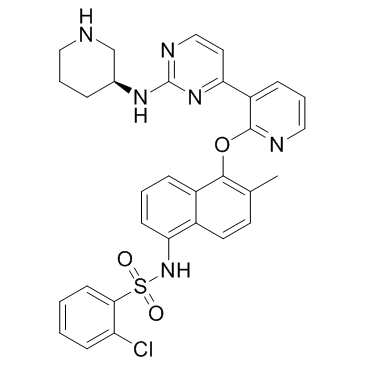| Cas No.: | 1630086-20-2 |
| SMILES: | CC1=C(C2=C(C=C1)C(=CC=C2)NS(=O)(=O)C3=CC=CC=C3Cl)OC4=C(C=CC=N4)C5=NC(=NC=C5)N[C@H]6CCCNC6 |
| Formula: | C31H29ClN6O3S |
| M.Wt: | 601.12 |
| Purity: | >98% |
| Sotrage: | 2 years -20°C Powder, 2 weeks 4°C in DMSO, 6 months -80°C in DMSO |
| Publication: | [1]. Morita S, et al. Targeting ABL-IRE1α Signaling Spares ER-Stressed Pancreatic β Cells to Reverse Autoimmune Diabetes. Cell Metab. 2017 Apr 4;25(4):883-897.e8. |
| Description: | In Vitro KIRA8 blocks IRE1α oligomerization, and potently inhibits IRE1α RNase activity against XBP1 and Ins2 RNAs. KIRA8 more potently reduces IRE1α-driven apoptosis in INS-1 cells than KIRA6 and also reverses XBP1 splicing promoted by GNF-2. In Vivo Kira8 efficaciously reverses established diabetes in NOD mice by sparing β-cells and preserving their physiological function. KIRA8 is first tested in 3-week-old male pre-diabetic Akita mice by i.p. daily dosing of 50 mg/kg, whereupon significant reduction of hyperglycemia became apparent over several weeks. Then KIRA8 (50 mg/kg) is tested in the complex NOD. Showing target engagement, one week treatment of pre-diabetic NODs with KIRA8 leads to significant reductions in islet XBP1 splicing and TXNIP mRNAs, and preserved Ins1/Ins2, BiP and MANF mRNAs. |
| Target: | IRE1α[1] |
| In Vivo: | Kira8 efficaciously reverses established diabetes in NOD mice by sparing β-cells and preserving their physiological function. KIRA8 is first tested in 3-week-old male pre-diabetic Akita mice by i.p. daily dosing of 50 mg/kg, whereupon significant reduction of hyperglycemia became apparent over several weeks. Then KIRA8 (50 mg/kg) is tested in the complex NOD. Showing target engagement, one week treatment of pre-diabetic NODs with KIRA8 leads to significant reductions in islet XBP1 splicing and TXNIP mRNAs, and preserved Ins1/Ins2, BiP and MANF mRNAs[1]. |
| In Vitro: | KIRA8 blocks IRE1α oligomerization, and potently inhibits IRE1α RNase activity against XBP1 and Ins2 RNAs. KIRA8 more potently reduces IRE1α-driven apoptosis in INS-1 cells than KIRA6 and also reverses XBP1 splicing promoted by GNF-2[1]. |
| References: | [1]. Morita S, et al. Targeting ABL-IRE1α Signaling Spares ER-Stressed Pancreatic β Cells to Reverse Autoimmune Diabetes. Cell Metab. 2017 Apr 4;25(4):883-897.e8. |

 To enhance service speed and avoid tariff delays, we've opened a US warehouse. All US orders ship directly from our US facility.
To enhance service speed and avoid tariff delays, we've opened a US warehouse. All US orders ship directly from our US facility.




















